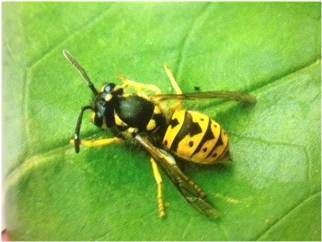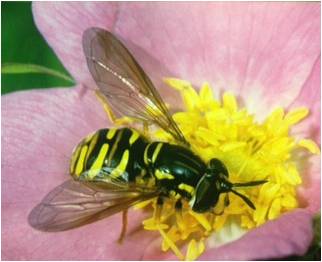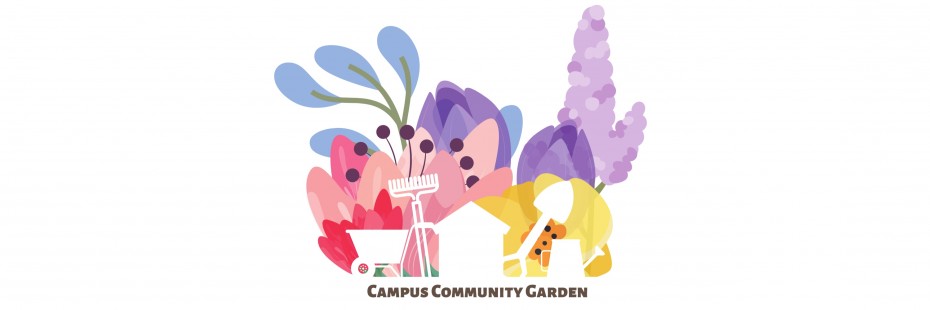Watch a short video of a Tobacco Hornworm found in our garden.
Name: Honey Bee (Apis Mellifera)

Physical Characteristics: Average size is 3/8 – 5/8 inches. Banded yellow and black abdomen, hairy thorax. The queen is usually larger in size than the worker bees, and typically remains out of sight. Worker bees transport pollen using their back legs.
Benefits: The honey bee is crucial to the pollination of many of the plants that humans rely on for food, such as fruits and vegetables.
Other: Humans have relied on honey bees for food and agricultural purposes for some 4000 years. In the spring, the honey bee population in a single hive can reach up to 50,000.
Habitat: North America; especially croplands, gardens, and forests.
Name: Bumblebee (Bombus)

Physical Characteristics: Average size is 3/5 – 1 inches. They tend to be larger than most other bee species, and are black with yellow markings mainly on the head and/or abdomen. Their bodies are covered in hair. The queen is larger than the workers.
Diet: Nectar and pollen
Benefits: Like the honey bee, bumblebees are pollinators.
Other: Bumblebees can sting, however it is highly unlikely, as they will only do so when provoked.
Habitat: North America; especially woodlands, gardens, and bogs/swamps.
Reference: Knopf, A. (1988). National Audubon Society Pocket Guide: Insects and Spiders. 12th ed. New York: Chanticleer Press, pp.112.
Name: Yellow Jacket (Vespula)

Physical Characteristics: 1/2 - 5/8 inches in length is an average size for a yellow jacket. They are thick in width and have prominent yellow markings on the abdomen (Knopf, 1988).
Diet: Yellow jackets generally eat the larvae of beetles and caterpillars. They are not pollinators (Espscience, 2013).
Benefits: Their diets consist mainly of pests, thus consuming them helps keep a garden balanced through natural pest control (Espscience, 2013).
Other: The prominent yellow markings on yellow jackets are an indicator for would-be predator birds to stay away from these insects, as they will sting if threatened (Knopf, 1988).
Habitat: North America; especially meadows and gardens (Knopf, 1988).
References:
Knopf, A. (1988). National Audubon Society Pocket Guide: Insects and Spiders. 12th ed. New
York: Chanticleer Press, pp.108.
Espsciencetime.org (2013). Yellow Jackets. [online] Retrieved from:
http://www.espsciencetime.org/student_life.cfm?subpage=327295 [Accessed: 4 Apr 2013].
Name: Hover Fly (Syrphidae)

Physical Characteristics: ¼ - ¾ inches in length is an average size for a hover fly. They often have yellow markings on their backs, though these markings are not as prominent as those of the yellow jacket species. They have a ‘false vein’ in their wings, which is a flap of wing cells that looks vein-like in appearance.
Diet: Nectar, obtained from spending much of their time hovering over flowers – hence the name Hover Fly.
Benefits: Though hover flies do not sting, their resemblance to bees in terms of stripes and behaviour help to protect them from potential predators, as most predators fear bees’ ability to sting. They benefits gardens in that they pollinate plants, without the danger of stinging gardeners, and their larvae feed on decaying plant and animal material.
Other: Hover flies’ diets are heavy in carbohydrates, as they need a lot of energy to allow them to hover over flowers for great periods of time. They usually lay eggs in moist environments such as wet soil.
Habitat: North America; especially in open fields, gardens, and woodlands.
Reference: Knopf, A. (1988). National Audubon Society Pocket Guide: Insects and Spiders. 12th ed. New York: Chanticleer Press, pp.106.
Name: Tachinid Fly

Image sourced form the CCGP photograph collection
Physical Characteristics: Has many different variations; most common are ones that resemble houseflies. Larva, are white grubs with no distinct head.
Diet: Adults: nectar Larvae: eat host insect inside out.
Benefits: Host specific, particular about what insect they attack, usually restricting themselves to only that species. Can devastate whole populations of pests.
Other: Lays eggs in host, usually near the head, on a plant material. If laid on a plant, the eggs either hatch and the larvae and then seek out a host, or eggs are eaten by the host insect, and then hatch inside. The larvae kill the hose in the process.
To attract tachinid flies plant: Golden marguerite, Buckwheat, Lemon balm, Pennyroyal, Parsley, Tansy, Crimson thyme
Reference: Proctor Foster, L., Fry, K., McCauley, D. (2008). Garden Bugs of Ontario . Edmonton Alberta: Lone Pine Publishing, pp 158
Name: Centipede

Image sourced from http://superscientastic.blogspot.ca/2010/04/horrifying-creatures-from-my-youth.html
Physical Characteristics: Adult: 20-40mm Immature 5-20mm, can be bigger, many legged, have curved pincers. Red or orange body. 1 pair of legs per segment.
Diet: Feed on insects that are smaller and slower than them
Benefits: One of the top predators
Negatives: If they are inside your house it means there are insects for them to feed on
Other: Habitat: Prefer moist, dark areas, including basements, moist soil, leaf litter and lawns. None are a threat to humans. They lay eggs in the soil in spring.
Attract them: They attracted to food, the more insects, the better.
Reference: Proctor Foster, L. et al. (2008). Garden Bugs of Ontario . Edmonton Alberta: Lone Pine Publishing, pp 198
Name: Pill Bugs (Armadillilium vulgare)

Image source: http://www.buzzle.com/articles/pill-bugs-control.html
Physical Characteristics: 5-12mm Adult, 3-10mm immature, 7 pairs of legs, armadillo like plates, can roll up into a ball to stop, dark brown to black. predators. Crustaceans
Diet: Detritivores; feed on decaying plant material.
Benefits: Clean up decaying plants
Other: Habitat-mostly urban areas, prefer moist soil and woody debris in urban gardens. Most active at night, they like the dark the most. Similar species exists. They are one of the few land crustaceans that have been able to adapt to land.
Reference: Proctor Foster, L. et al. (2008). Garden Bugs of Ontario . Edmonton Alberta: Lone Pine Publishing, pp 203
Name: Striped Cucumber Beetle

Image source:"the little garden that could" website (no longer available)
Physical Characteristics: 10-20mm, 3-10mm, Adults - head and pronotum (section of insect with first pair of legs) roughly same in width, wider elytra which is marked with black and yellow stripes; larva: black or yellowish, elongated, segmented, rough looking like an alligator
Diet: Loves cucurbit crops (squash, melons, gourds), cucumbers. Adults feed on foliage, larva are more damaging and feed on the roots. Especially loves cucumbers.
Benefits: No benefits to gardens
Negatives: A Pest to Gardens, especially cucumbers. Can cause bacterial wilt, and cucumber mosaic virus.
Other: Habitat: Prefers cucumbers (most leaf beetles are named after their favoured plant) Plant in various areas to limit damage done to plants. General predators take care of larvae, and the bugs themselves.
Reference: Proctor Foster, L. et al. (2008). Garden Bugs of Ontario . Edmonton Alberta: Lone Pine Publishing, pp 84
Name: Earthworm

Image Source: http://arstechnica.com/science/2012/12/earthworm-guts-become-factory-for-nanoparticles/
Physical Characteristics: Adult 5-25cm, immature 1-5cm. Elongated pink to reddish body; segmented with collar (clitellum) near front. No legs or identifiable head. Immature: have no Clitellum
Diet: Consume decaying organic matter. Feeds well into the ground. Break down organic material which is good for the garden.
Benefits: Break down organic material, aerate the soil creating passages way within the soil aeration, better porosity and permeability. Great at mixing dirt. Created castings (organic waste material) that hold moisture from the air, which in turn help support plant life. Decomposers and other insects all benefits from worm castings.
Negatives: If there is a large earthworm population it suppresses weed growth
Other: All worms are hermaphrodites. Takes a year for immature worms to become mature. Can live up to 9 years.
Reference: Proctor Foster, L. et al. (2008). Garden Bugs of Ontario . Edmonton Alberta: Lone Pine Publishing, pp 205
Name: Grasshopper

Image Source: http://www.grasshoppercontrol.com/
Physical Characteristics: Dark brown to green or light yellow. Enlarged hind-legs for jumping. Adult is around 4 cm. The nymph are like adults except without developed wings, and range from 5mm to 4cm
Diet: Prefer different types of plants depending on grasshoppers. The Migratory Grasshopped, is one of Ontario’s most successful species, favours anywhere that has grass and weeds.
Benefits: None to gardens or farms. They will strip plants bare.
Negative: Strip plants bare. Particular abundant in dry years.
Other: Lots of predators feed on grasshoppers, velvet mites, ground beetles, rove beetles, and blister beetles eat grasshopper eggs.
Turn over soil in autumn to expose deeply buried grasshopper eggs, thus stopping their reign of terror. Ground beetles like to hideout underneath rocks, leaf litter, and woody debris—so adding a nice layer of wood chips or shredded leaves to ornamental garden beds and pathways provides plenty of habitat.
Plant ground covers. Low growing plants, including edibles like sage, savory, thyme, and strawberries also provide shelter for ground beetles.
Reference: Proctor Foster, L. et al. (2008). Garden Bugs of Ontario . Edmonton Alberta: Lone Pine Publishing, pp 49

